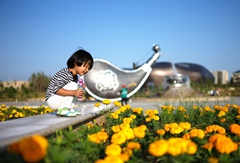Recovering wastelands: trees and crops emerge from sand
Updated: 2017-09-04 (chinadaily)  Print
Print 



Spending more than 30 years turning deserts green, Yin Yuzhen, an ordinary farmer in Ordos, the Inner Mongolian autonomous region, created a miracle in what was previously wasteland.
She and her family have planted approximately 60,000 trees in recent years, covering an area of more than 4,000 hectares deep in the heart of the Maowusu Desert, one of the largest of its kind in the country.
“There has been a dramatic change in my home, compared with decades ago,” the 52-year-old told Chinese media.
She left her hometown in neighboring Shaanxi province and married Bai Wanxiang in the desert area in Uxin Banner, an administrative unit under Ordos, in 1985 because of her father’s promise. But, she was depressed about what she had to face — the wildness of the wind, frequent sandstorms and seemingly endless deserts, which left the newlyweds in poverty and loneliness.
A sandstorm could last for more than a month in the desert area, which blanketed everything and also darkened Yin’s life. Anyone captured by the storm was coated with sand and even their mouth and nose couldn’t escape, she recalled.
At that time “the area was bleak and desolate, and no visitors were in sight for weeks”, Yin said, adding that the nearest neighbor lived 20 kilometers away.
An occasional stranger passing by would excite her, she said. To keep the visitor’s footprint in the sand, she put an upside-down basin on it.
“When I had spare time, I would like to look at it, as if it were my family,” she said.
To survive the misery, Yin decided to plant trees. “I’d rather die of exhaustion for planting than be bullied by sands,” she said.
In 1986, she and her husband spent the money that they earned by doing odd jobs on 600 new saplings. They planted the young trees around their house and took care of them every day.
Less than 10 of them survived the droughts and winds. But, this didn’t defeat the couple, who instead held onto a glimmer of hope.
Even if one tree can withstand the environment, it indicates that a larger group could succeed, she said.
Later, they bought another 50,000 poplar saplings from a faraway nursery. On their back way home, the couple encountered fierce winds and had to load the saplings that the wind had blown off back onto their cow again and again.
After the trees were finally planted, the majority of them were blown away as yet another sandstorm swept the region. Yin learned a lesson from the failure and came to the conclusion that brushwood needed to be prepared ahead of planting trees to minimize damage from the wind.
To date, the plantation has expanded to thousands of hectares, which has also drawn various birds and animals.
“From the first tree I planted, I’ve never thought of quitting,” she said. “To protect our common home, the Earth, I’ll continue growing more trees and take care of them like my children,” she said.
Inspired by her story, her neighborhood has also joined in the environmental efforts. Currently, more than 240 families each have a tree plantation covering at least 20 hectares in Uxin Banner. The green coverage in the region has increased to 85 percent today from 45 percent 10 years ago.
With the green coverage expansion, Yin herself has blossomed into a noted environmental fighter.
Acclaimed as real heroes for their afforestation efforts, Yin and her husband receive throngs of visitors annually despite being tucked away deep in the desert.
Volunteers from China and other countries, including the United States, Germany, France and South Korea, have helped them to plant trees.
Yin cited some of the foreign volunteers as examples to illustrate their strong environmental awareness.
After washing their faces, they reused the water for their feet and then the trees, she said. “Despite the language barrier, I can see through such details that they are saving water — they know water is the most precious resource in the desert.”
Her persistent fight against desertification has won her a series of honors and awards, including the Gaia Prize granted in South Korea. She has received awards or given lectures in more than 10 countries and regions, campaigning for environmental protection.
Yin’s vision of the future for her home is far more than turning the desert green. She said she has put her eyes on fruitful commercialization and industrialization as another approach to sustainability.
In 2005, she founded an agricultural company selling livestock and organic foods from her own farm, producing goods such as millet, watermelon and corn.
She envisioned a green, recycled economy, where trees help to prevent soil erosion, which enables a crop harvest. Crops, in turn, can be sold and also used to keep livestock.
Fruit trees have become an attraction in developing rural tourism and, at the same time, provide a new source of income after the fruits are processed.
Yin said her short-term goal is to establish a small fruit-processing plant.
“Governmental financial aids and sponsorships from the private sector have helped our development,” she said. “Yet as our business is growing, we need to consider other options.”
The farmer-turned-entrepreneur said she is contacting bankers to explore cooperation possibilities. Given her poor formal education, Yin said she aspires to receive training in management.
She has registered the Chinese characters mo hai as a trademark of her company’s products, which literally means desert sea.
“While the desert looks wild, it can be tapped like the sea, which is rich in treasures and wealth.”





 Ordos Impression
Ordos Impression Ordos WeChat
Ordos WeChat Ordos Reported
Ordos Reported


